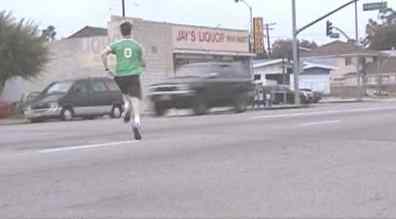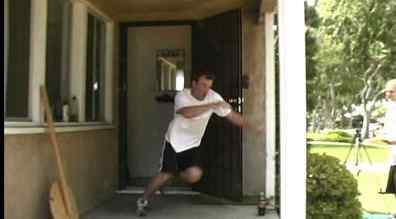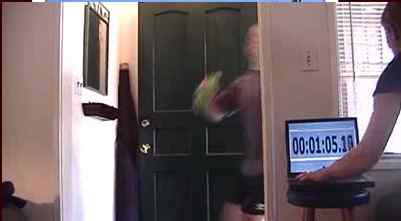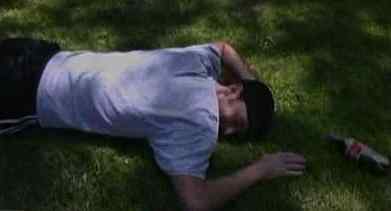Come down to L.A. and run - Brett and Keith of "Run to Jay's"
 Brett Spackman (director) and Keith Paugh (co-producer) attended the 2005 Austin Film Festival to be present at screenings of their documentary short film Run to Jay's: Tournament of Champions. I sat down with them in the lobby of the Stephen F. Austin hotel to talk about their movie, which later won the AFF 2005 Audience Award for Documentary Short Film. In the film, friends race from Spackman's home to a nearby convenience store to see who can purchase a soda and return to the house in the shortest time.
Brett Spackman (director) and Keith Paugh (co-producer) attended the 2005 Austin Film Festival to be present at screenings of their documentary short film Run to Jay's: Tournament of Champions. I sat down with them in the lobby of the Stephen F. Austin hotel to talk about their movie, which later won the AFF 2005 Audience Award for Documentary Short Film. In the film, friends race from Spackman's home to a nearby convenience store to see who can purchase a soda and return to the house in the shortest time.What were some of the rules and challenges of the race that didn't make it into the film?
Brett: One really important aspect is the actual purchase of the soda. We used to wait to give the money to the cashier and get change back. That quickly changed when one of the guys ran and there were a bunch of people in there. He got all stressed out so he just laid the money down on the counter, grabbed the Coke and ran out. That became the way to do it. You just run in with exact change and you slam it down – you don't care who's there, you don't even care if the cashier's there, and you run out and bolt home.
Other rules that developed over time were: not crossing the neighbor's yard because of the flower garden, and -- essentially the contest has no rules. Get down there as fast as you can and book back as fast as you can, but don't get hit by a car.

Have there been people who have tried to bend the parameters of the game by doing it during different times of the day when there's less traffic, stuff like that?
Brett: It actually doesn't really matter when you do it. A lot of people think that nighttime's the best time to do it, but I totally disagree with that. Basically, as long as you have no traffic and you're a fast runner you'll have a good time. So we've had guys break the record at night, we've had them break the record Saturday afternoon, rush hour, it doesn't really matter.
How well known is the competition in the community?
Keith: It's kind of well-known in circles [rather] than in the community, I would say. Groups of friends -- the group of friends who started it have had friends who have come and joined in. People who have seen the film at either festivals or in various editions of the film -- it's kind of grown over time, as a documentary and [as a race] -- get excited about it and want to come out and run it themselves.
Brett: The neighbors kind of understand what's going on now but at first they got a little confused by it. There were some teenaged kids watching what was going on; they saw one girl run out of the store with a soda and they thought she had stolen something. They ran after her and didn't catch her but then realized what we were doing.

Has there been any local media coverage?
Brett: Not yet -- there probably would be if we caused a car wreck or something, but nothing's happened yet.
Keith: I think by the nature of the race we're hoping for less coverage rather than more. I'm sure we'd get shut down right quick for a number of reasons.
One of the neighbors installed a flower bed in their yard after the race was established. Was that in response to the race?
Keith (laughing): I never thought of it that way.
Brett: I don't think so. I think they just wanted to beautify their yard but maybe, I don't know. They don't really talk to us that much.
Keith: It was hard for me, I had hoped to develop the Fosbury Flop of the Jay's Run, not only by running through the first yard but jumping over the fences of the next, but that's no longer possible.
What about the timing of the race -- how technically complicated is that?
Brett: Well, first we started off with a normal stopwatch and immediately there was controversy, because people were saying "He didn't start it [at the same point] when I ran" or "He didn't stop it soon enough when I crossed the finish line" . . . eventually we just developed the photo finish, which is just a laptop in front of the door with the camera pointed at it. That way we could frame advance through and see exactly when they crossed. That became the official "Jay's Time."
One of the other documentary filmmakers has talked about a narrative version of his film. What would a narrative version of Run To Jay's be like?
Brett: It would probably be Dodgeball-esque I guess – some guy trying to be heroic at something that's not too admirable or respected outside of their own community. We've actually had suggestions of how to make that into a narrative and I just don't know if the Run to Jay's is big enough of a subject to be made into a narrative feature. It would have to be a "slacker dreams big" type movie.
Keith: I think [the film's] charm is the fact that it's real and silly and being taken seriously. I think that's why it's entertaining to those who see it.
I take it Jay has seen the movie?
Brett: Jay has seen the first version. There was an original version of the documentary and he saw the first version and was amused by it but he has kind of remained neutral on the subject. He never likes to talk about it. When we tried to get him on film, he reluctantly agreed after we had one of the Korean girls go and talk to him in Korean. Her flirtations kind of won him over. But [Mrs. Jay] loves it. We never got any of it on film but any time anyone runs in, grabs a Coke, and drops the money she cheers them on. She's like "Yaaaay!" but Jay himself is just -- he just shrugs his shoulders.
So long as you're buying soda.
Keith: Exactly. I think he tolerates it more than anything but Mrs. Jay loves it. Mrs. Jay is always great. If you're tired and you get into Jay's and she's there, then it's a burst of support. A little fan there for us.

Both of you have competed, right?
Brett: I used to be the one-time champion, but my chances of being the champion are long gone. We've had an Olympic bobsledder run it since the film was completed and he's the new record holder.
What's his name?
Brett: Erik Oh.
Keith: What's his time?
Brett: 57.10.
What's your time?
Brett: 1:01.10.
Keith: 1:02.10. Texas ladies, I'm available.
Are there any injury war stories related to the Jay's Run?
Brett: No one's been hurt, but there's been dancing around cars, brakes screeching to a halt, spills on the sidewalk, and slips in the store. But no broken bones or concussions just yet.

Is there a favorite brand of shoe among competitors?
Brett: I don't know if there's a favorite brand of shoe but there's Cokes everywhere in the cooler. For some reason, the fastest runners never take the Cokes. They take the Diet Seven-Ups and the Fantas --
Keith: Sprite.
Brett: Sprite.
So it's time to talk sponsorship?
Brett: Exactly.
Keith: One aspect of the film that was fun for us and that people like to ask about is the multiple cameras -- I think at one time we used, what, seven?
Brett: About seven cameras.
Keith: About seven cameras in all -- there's a jib that we built for some of the street shots and a good length of dolly track that we ran for the first stretch of the race. It was fun for us to figure out how we were going to dynamically cover this race in a way that would be engaging to watch, and kinetic, and demonstrate how fast these people are moving, and how tired they are upon their return.
Brett: One aspect of the race that doesn't come out in the film is how difficult the race is. A lot of people say "Oh, I could run for a minute," but they don't realize it's like a four-hundred meter dash only you have to re-accelerate after two-hundred meters. It gets a laugh in the film but it's true, it is mentally draining to sprint two-hundred meters and then go "ugh, I gotta turn and go back." Then to re-accelerate and go home, it kills you. People who think it's easy need to come down to L.A. and show their stuff.
Tell me about the animated credits sequence.
Brett: The history of Run to Jay's I wanted to get done really quickly -- I wanted people to understand the race really quickly. I decided that it needed to be explained twice before the actual movie began. So there's the animated sequence right before the title sequence where you see the camera go back and forth really fast and then you have the aerial shot where the animation comes down and you see the little arrows go into the store, buy [a soda] and come back. A friend of mine by the name of Brent Barson did that. With those two things, once you have the mental picture of where the race track is, what needs to be done, you're ready to go into the intricacies and have all the blurred race footage and you won't be confused.
So what's next?
Keith: We just finished a feature-length comedy by the name of Think Tank; the trailer can be seen at www.thinktankthemovie.com. A group of friends and I wrote this and have been working to get it produced. It'll be coming out in early 2006, probably January or February in a limited release, so that's been fun. Brett and I are always involved keeping ourselves sane and in practice making a lot of short films. We're both kind of narrative filmmakers, or at least think of ourselves as narrative filmmakers but always end up making documentaries. Both of us have made a few because sometimes reality is just too good to be true. In the meantime we've been working on some other short projects. We've worked on one together called Four Walls that Brett directed. So a lot of small projects similar to this be they documentary or narrative.
Anything else?
Brett: Come down to L.A. and run, man. I live in the house where it's run. Go to www.runtojays.com and look me up and let's run.
Keith: We'll even supply the $1.35 for the soda. Take that aftermath footage seriously, all those people looking tired and spent, that's serious stuff. You feel like you'd rather throw up at the end of this thing than drink that soda.
Brett: It's fun to watch, but it's no fun to do.


1 Comments:
I would just like to say that brett spackman is the biggest dork that I have ever met. Thanks
Post a Comment
<< Home